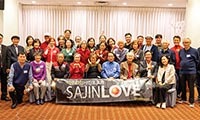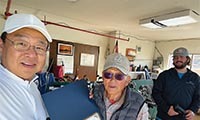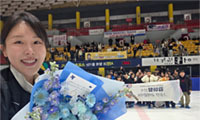March 1st in Modern Times
▶ 삼일 운동 백주년 기념 경운 장학회 주최 제9회 영어 웅변대회 수상작- Finalist
On one of these days, my parents dragged my sister and me to a small, unsuspecting building.
What could have possibly taken place here that held any of the “cultural richness” my parents had been after the entire trip?
We stepped inside and I soon learned that the building was the home of the Imshijungbu, or the Provisional Korean government that was active during the Japanese occupation.
This didn’t mean much to me then. But when I started doing research for this contest, I realized that I had been somewhere truly special.
The March 1st Movement was the first of many civil demonstrations held by the Korean people to oppose Japanese rule. Around 2 million people in total played a role in the movement. Everyone, no matter their class, gender, age, or job participated. All the protesting gave way to the birth of the Imshijungbu on April 11, 1919, which formed its own constitution and led us to our independence.
This ultimately led me to realize that Samilundong was more than the movement that sowed the seeds for our eventual independence. It was a testament to fighting injustice by banding together and calling for the end of oppression with one collective voice.
That spirit is reflected in the way every Korean came together in the face of struggle. No matter who you were, you were in the streets, singing together. Shouting together. Alone, you might not have amassed enough power to scare the Japanese government into violently repressing the movement. Alone, you might not have had the bravery to fight that violence with peaceful protest.
Sometimes, I look around and wonder to myself where that spirit lives on in the Korean-American community. How can the lessons of Samilundong apply to the societal issues we face in America today?
Because sometimes, we don’t care about something unless it affects us.
Maybe the reason we turn away from the struggle of others is because Samilundong happened in the past. And it’s always easier to look and ponder things in retrospect than to see the gravity of the wrongs happening right now. But the spirit of Samilundong isn’t something that can be restricted to the past. That’s because it is a reflection of the human spirit. It’s ingrained in our past, relevant in the present and vital to our future.
This is why we have to turn our attention to America.
As a Korean-American student, I see divisiveness pervade the way we talk about affirmative action and the students of color who benefit from it. I see so much negativity surrounding the discussions had about black students who get into prestigious colleges. How this impacts the way we speak about black people in general.
I wondered why we were trying to separate ourselves from the people who had experienced discrimination, not the same, but similar to ours.
The model minority stereotype was the answer to my question. This stereotype showed up in the 1960s during the Civil Rights Movement as an indirect way for white people to quell the rising tide of the Movement. Our financial and social success was compared to that of black citizens on account of us both being minorities. Why were we doing better than black people? Why couldn’t black people pull themselves up by the bootstraps as we had? But our success had little to do with us working hard and becoming educated and more to do with the better treatment we received so we could be groomed into something that could be used as a model to denigrate black people for not being able to reach the same level of success. We appealed to the people in power, and we were used as tools to further anti-black sentiment in America.
We benefited from that racism. And we stayed quiet.
But in spite of all our silence and obedience, the culture we had tried so hard to make ourselves a part of, held us at arm’s length.
It is strange to see people who are so proud of their ancestors using their voices not standing up and using theirs.
It is strange to see the divide between us, especially when black people struggled in the Civil rights movement for racial equality in a vein similar to the March 1st Movement.
We cannot deny to help and stay silent when we see injustice and then turn right around and expect others to help us.
And help is needed desperately today. We saw white supremacists openly celebrate during Charlottesville’s Unite the Right rally. We watched as policemen killed 1,147 people in 2017, 25% of whom were black. We experience increased crime as the Asian community.
Sometimes, I read this news and feel insignificant. Like I cannot make an impact on the world around me.
But then I remember the small, dingy building, that didn’t seem like much to the naked eye but housed something much greater than the sum of its parts. I remember people that saw injustice and stood against it, even if it meant sacrificing themselves. I remember all the individuals that came together despite everything that made them different.
I remember that there are still problems we face today, but that we can overcome those problems, should we choose to use our voices to unite with other people of color in America.
To me, Samilundong is great not only because of what it accomplished but also because it showed what could be.
<Emily Gil 11th Grade Bergen County Technical School>
스마터리빙
more [ 건강]
[ 건강]이제 혈관 건강도 챙기자!
[현대해운]우리 눈에 보이지 않기 때문에 혈관 건강을 챙기는 것은 결코 쉽지 않은데요. 여러분은 혈관 건강을 유지하기 위해 어떤 노력을 하시나요?
 [ 건강]
[ 건강]내 몸이 건강해지는 과일궁합
 [ 라이프]
[ 라이프]벌레야 물럿거라! 천연 해충제 만들기
 [ 건강]
[ 건강]혈압 낮추는데 좋은 식품
[현대해운]혈관 건강은 주로 노화가 진행되면서 지켜야 할 문제라고 인식되어 왔습니다. 최근 생활 패턴과 식생활의 변화로 혈관의 노화 진행이 빨라지고
사람·사람들
more
“취미생활로 다진 친목… 선후배들과 만든 모교사랑”
사진러브한인 사진 동호회 사진러브(회장 크리스 고)는 13일 용수산에서 송년모임을 갖고 한 해를 마무리하는 뜻깊은 시간을 가졌다. 이날 모임에…

[홀인원] 이상원 박사
일반외과 전문의 이상원(왼쪽) 박사가 지난 9일 뉴포트비치 소재 골프장 9번 홀(152야드)에서 레스큐 클럽으로 친 샷이 그대로 홀에 빨려 들…
[송년행사 게시판] 재미시인협회
재미시인협회(회장 지성심)는 오는 20일 오후 4시 가든스윗호텔에서 한 해를 마무리하며 동인지 ‘외지’ 제35집 출판 기념회와 ‘제23회 재미…
[송년행사 게시판] 향군단체 연합
6.25 참전유공자회와 대한민국 육군협회 등 남가주 지역 향군 단체 연합은 19일 오전 11시30분, 용궁에서 송년 행사를 개최한다. 드레스코…
[송년행사 화보] “이웃과 함께 나누고 지인과 함…
KYCC13일 윌튼 플레이스 초등학교에서 열린 ‘한인타운청소년회관(KYCC) 홀리데이 카니발’이 성황리에 막을 내렸다. 올해는 KYCC 창립 …
많이 본 기사
- 판례 잘못 인용해 머스크 손들어준 판사… “AI 쓰다 오류” 의혹
- 아마존, 키보드입력 데이터 분석해 위장취업 北노동자 적발
- ‘공천개입’ 이준석 첫 특검 출석… “尹과 공범엮기 무리한 시도”
- ‘反트럼프’ 공화 큰손, 작년 대선에만 약 5억4천800만달러 썼다
- “산타 지금 어디쯤?”…한국서도 70년 전통 전화 안내 즐긴다
- 청와대 내년부터 본격화…여민관 ‘정책허브’로
- ‘중독유발 비판’ 챗GPT, 아동보호 기능 이어 ‘친절함 정도’ 도입
- 엡스타인파일 공개 후폭풍…법무부 ‘트… 2
- 30년 만에 의문의 비극…과 동기에 피살 ‘승승장구’ MIT 교수
- ‘열애설→결별설 겪은’ 제니·지드래곤, 단둘이 ‘MMA’ 대상 쓸어갔다
- 신민아♥김우빈, 결혼식날 전한 깜짝 … 1
- 머스크 재산… 사상 초유 7천억달러 돌파
- ‘SNS검증’ 美비자심사 지연에…빅테크, 또 직원 출국자제 권고
- ‘미소천사’ 김아랑, 너무도 진솔했던 ‘은퇴 이유’ 고백 “경기 후 아쉬움 아닌 고마움 들어 결심했다”
- [건강포커스] “밤에 더 자주 깨는 어르신, 다음 날 인지수행 능력 떨어져”
- ‘손예진♥’ 현빈, 학부모 모드ON.. “아들이 배우 한다면? 하..” 한숨
- ‘부상 아웃 공식 확정’ 이강인, 절뚝일 때부터 이상했다 “왼쪽 허벅지 근육 이상”... 폼 최고였는데 아쉬워
- ‘새댁’ 함은정, 결혼식 하자마자..내조의 여왕
- 尹 김건희특검 첫 조사 8시간 반 만에 종료…6개 혐의 모두 부인
- 요르단 “美 시리아 IS 공습에 참여…안보 위협 저지”
- “네타냐후, 트럼프 만나 ‘이란 추가 타격’ 설명 계획”
- 美, 베네수 연안서 유조선 추가 나포…긴장 또 고조될 듯
- 與 “내란 2차 종합 특검해야”…국힘 “통일교 특검이 국민 명령”
- 안세영, ‘천적’ 야마구치도 넘었다…역대 최다승까지 단 한 걸음
- 젤렌스키 “우크라 선거 방식, 푸틴이… 3
- 위성락 “내년부터 농축·재처리·핵잠 한미협의 동시다발 진행”
- ‘이젠 SD 송성문’ 3루엔 ‘3억 5000만 달러’ 마차도 버티는데... 단장이 답했다 “다양한 역할 소화할 것”
- 트럼프, ‘바이든 임명’ 직업 외교관 출신 대사들 대거 소환
- 교황, 전세계 추기경 바티칸 소집…내달 7∼8일 첫 회의
- 쿠팡 주주, 美법원에 집단소송… “정… 1
1/5지식톡

-
 ☝️해외에서도 가능한 한국어 선생님…
0
☝️해외에서도 가능한 한국어 선생님…
0이 영상 하나면 충분합니다!♥️상담신청문의♥️☝️ 문의 폭주로 '선착순 상담'만 진행합니다.☎️ : 02-6213-9094✨카카오톡ID : @GOODEDU77 (@골뱅이 꼭 붙여주셔야합니다…
-
 테슬라 자동차 시트커버 장착
0
테슬라 자동차 시트커버 장착
0테슬라 시트커버, 사놓고 아직 못 씌우셨죠?장착이 생각보다 쉽지 않습니다.20년 경력 전문가에게 맡기세요 — 깔끔하고 딱 맞게 장착해드립니다!장착비용:앞좌석: $40뒷좌석: $60앞·뒷좌석 …
-
 식당용 부탄가스
0
식당용 부탄가스
0식당용 부탄가스 홀세일 합니다 로스앤젤레스 다운타운 픽업 가능 안녕 하세요?강아지 & 고양이 모든 애완동물 / 반려동물 식품 & 모든 애완동물/반려동물 관련 제품들 전문적으로 홀세일/취급하는 회사 입니다 100% …
-
 ACSL 국제 컴퓨터 과학 대회, …
0
ACSL 국제 컴퓨터 과학 대회, …
0웹사이트 : www.eduspot.co.kr 카카오톡 상담하기 : https://pf.kakao.com/_BEQWxb블로그 : https://blog.naver.com/eduspotmain안녕하세요, 에듀스팟입니다…
-
 바디프렌드 안마의자 창고 리퍼브 세…
0
바디프렌드 안마의자 창고 리퍼브 세…
0거의 새제품급 리퍼브 안마의자 대방출 한다고 합니다!8월 23일(토)…24일(일) 단 이틀!특가 판매가Famille: $500 ~ $1,000Falcon: $1,500 ~ $2,500픽업 & 배송직접 픽업 가능LA…
케이타운 1번가
오늘의 1면
오피니언
 한영일 / 서울경제 논설위원
한영일 / 서울경제 논설위원[만화경] 웰다잉 인센티브
 캐슬린 파커 워싱턴포스트 칼럼니스트
캐슬린 파커 워싱턴포스트 칼럼니스트 [캐슬린 파커 칼럼] 아이들을 온라인에서 보호하기
 양상훈 수필가ㆍ시인
양상훈 수필가ㆍ시인 [한국춘추] 경제대공황ㆍ제2차 세계대전 승리로 극복한 루스벨트 리더쉽

[왈가 왈부] 고환율에 외환 건전성 완화·서학개미 규제… 미봉책 아닌가요
 수잔 최 한미가정상담소 이사장 가정법 전문 변호사
수잔 최 한미가정상담소 이사장 가정법 전문 변호사 [수잔 최 변호사의 LIFE &] AI 시대 편리함에 안주하지 말자
 김도년 성균관대 건축학과 교수 스마트도시·건축학회장
김도년 성균관대 건축학과 교수 스마트도시·건축학회장 [로터리] 지멘스가 만드는 미래 동네
1/3지사별 뉴스

퀸즈장로교회 ‘사랑의 바구니’130개 이웃에 전달
퀸즈장로교회가 18일 크리스마스를 앞두고 교인들의 정성과 사랑이 듬뿍 담긴 ‘사랑의 바구니’ 130개를 소방서와 경찰서, 요양원, 선교회, 그…
시민권 박탈 착수⋯매달 200명

“이웃 돌보는 여러분이 동역자”
워싱턴성광교회(담임목사 임용우)는 18일 한인단체와 소방서‧도서관 등에 총 2만9천 달러의 성금을 전달했다. 지난 2011년부터 15년째 지역…
소기업 지원에 1천만 달러 투자

위기의 트럼프 “내년봄 최대규모 세금환급”
트럼프 대통령은 17일 “취임 1년 만에 우리는 누구도 상상하지 못한 성과를 이뤄냈다”고 말했다.트럼프 대통령은 동부시간 이날 밤 9시부터 백…
[새해부터 이렇게 달라진다] 최저임금 또 오르고… 유급 병가는 더 확대

오늘 하루 이 창 열지 않음 닫기 




















































.png)


댓글 안에 당신의 성숙함도 담아 주세요.
'오늘의 한마디'는 기사에 대하여 자신의 생각을 말하고 남의 생각을 들으며 서로 다양한 의견을 나누는 공간입니다. 그러나 간혹 불건전한 내용을 올리시는 분들이 계셔서 건전한 인터넷문화 정착을 위해 아래와 같은 운영원칙을 적용합니다.
자체 모니터링을 통해 아래에 해당하는 내용이 포함된 댓글이 발견되면 예고없이 삭제 조치를 하겠습니다.
불건전한 댓글을 올리거나, 이름에 비속어 및 상대방의 불쾌감을 주는 단어를 사용, 유명인 또는 특정 일반인을 사칭하는 경우 이용에 대한 차단 제재를 받을 수 있습니다. 차단될 경우, 일주일간 댓글을 달수 없게 됩니다.
명예훼손, 개인정보 유출, 욕설 등 법률에 위반되는 댓글은 관계 법령에 의거 민형사상 처벌을 받을 수 있으니 이용에 주의를 부탁드립니다.
Close
x